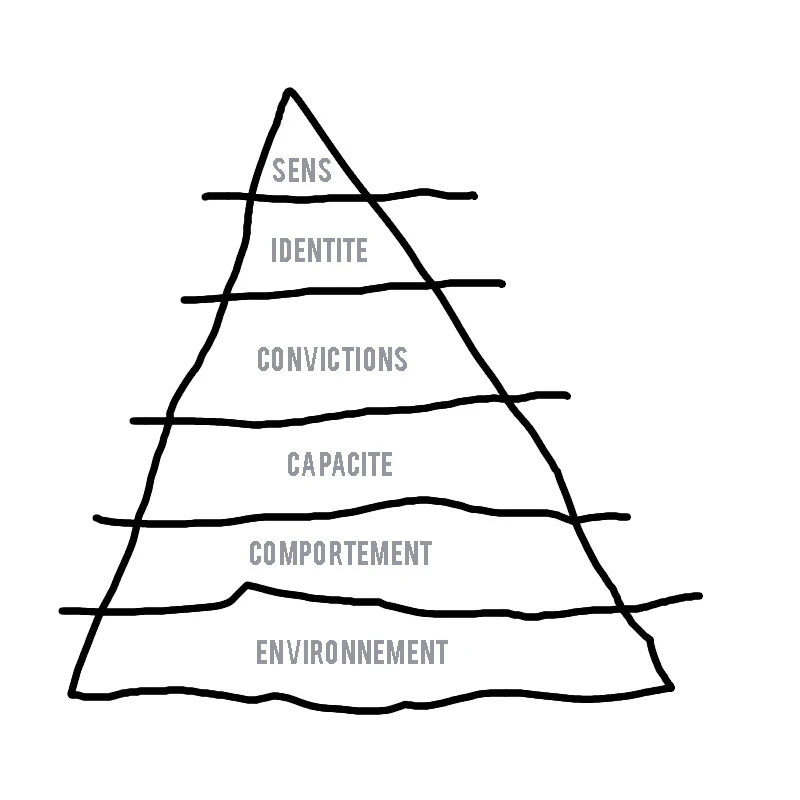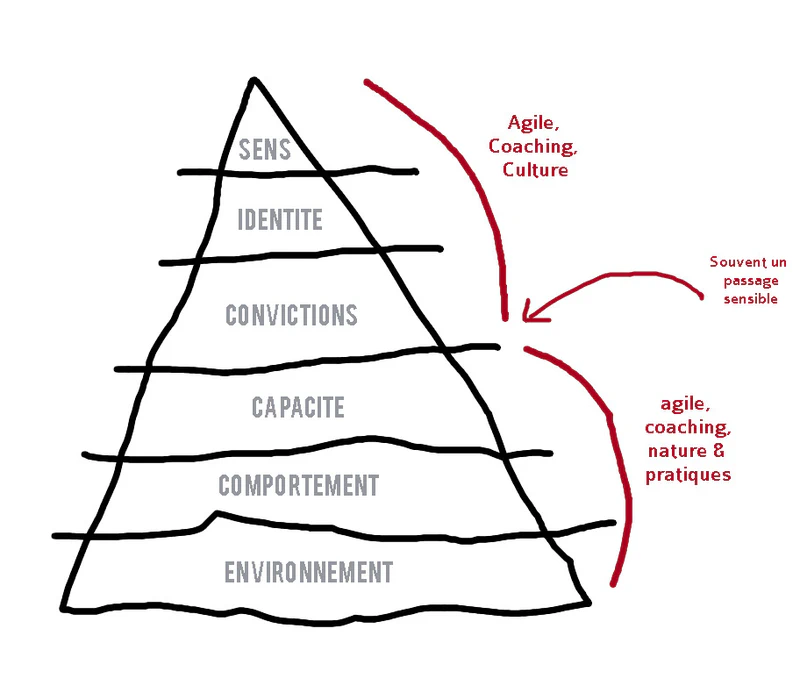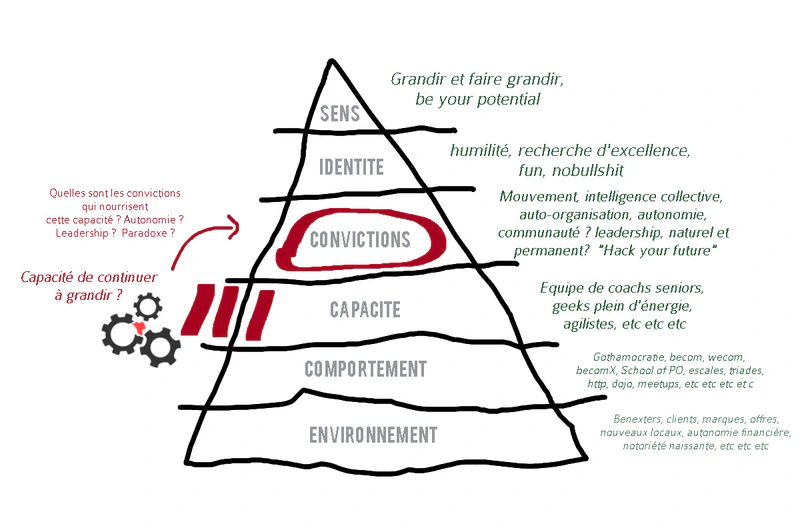Previously and around Kanban I talked to you about corporate culture, organization, and the need to adapt to it in order to support the organization. I would like to complement this reading by adding the need for this culture to be aligned, in harmony, “at all levels”. For this and in my ongoing reflections at beNext, I want to talk to you about the Dilts pyramid (which Dilts draws from Bateson).
In this reading of the Dilts pyramid I take liberties, I adapt, I make it my own, it’s my way of being more coherent with the world around me1. So here’s my way of talking about it, of using it. The Dilts pyramid aims to harmonize, to align the organization, so that it can move forward, breathe, flourish, potentially expand. Align? Harmonize? That is to say that there exists a link, a coherence, between why the organization exists, who it is, what it believes in, what it implements, etc. Each of its levels feeds the level below it.

My reading of the levels
- Purpose. What is our mission? Why does this organization exist? What is its goal?
- Identity. Who is it? What defines its identity?
- Beliefs. What are its beliefs? Its convictions? What does it believe in?
- Capability. What are our levers? What do we rely on to achieve what we achieve?
- Behavior. What do we actually do? How do we act?
- Environment. What surrounds us? Implied: what have we built around ourselves, and what have we inherited?
Purpose feeds identity or vice versa. “I am this therefore my mission is” or “my mission is therefore I am”. Identity feeds beliefs or vice versa. “I am this therefore I believe in” or “I believe in … therefore I am this”. Beliefs feed capability, or vice versa. But here it’s not so simple, we feel that we’re moving from a cultural level to an operational level (we’ll come back to this). “I believe in this therefore I give myself the means to” or “I have the means to … I should have as a belief”. Capabilities feed behavior, or vice versa. “I do this thus I will have the means to …” or “I have the means to … in order to do this”. Behaviors feed the environment, or vice versa. “I act this way and it creates this around me” or “With this around me I can act this way”.
How is reading the pyramid useful?
You therefore understand that each level feeds the other, and if you manage to align, to harmonize, all these levels, if there is no dissonance, you give your full power, you liberate your organization. Everything is more fluid, obvious. In the opposite case, if the levels are dissonant, exchanges work poorly, misunderstandings or blockages flourish, the organization is seized up.
It is therefore important to question: which levels are dissonant? Which levels are not sufficiently clarified? Which levels are seizing up the organization? And generally to work on them or on the level that overhangs it, the level above, because it’s often the upper level that poorly feeds the lower level. I’ll give you examples of my point.
Examples for organizations
Large groups doing “agile at scale”
You know these large groups that are currently massively relying on agile “frameworks” to become agile. The problem is that they give themselves the means of a capability (massive hiring), behaviors (massive support), and often the resulting environment. But the beliefs, the convictions of managers, of executives are not at all aligned with this capability and its behaviors. Their beliefs are often not – for example – self-organization, autonomy, technical excellence, the right to fail, etc., which should be agile principles, agile beliefs. We get a clear split between these levels. All sorts of drifts, absurd behaviors, suffering result from this.
This is why SAFe is very often a failure for example. Because it is the most dissonant! It implements so-called agile behaviors ("feature teams, synchronization points (quarterly planning), etc.,) but supports through the communication and culture it propagates, an identity and beliefs in opposition to the practices it partially describes.
How to fix this? If you massively implement an agile capability, and agile behaviors (massive hiring, support), it is imperative to question yourself about the level above so that this happens harmoniously: are your beliefs also close to agile principles? It’s often no. The problematic level is therefore that of beliefs. To resolve it, like Russian dolls, we must therefore question our identity (and perhaps our purpose, our mission). Who are we? What do we want? If this becomes clear, it will be easier to see how your beliefs (clarified) will be (or not) compatible with agile culture and approach. If this is the case, everything will become more fluid. If this is not the case, no point trying to have a capability or behaviors at odds with your beliefs.
Personal development coaches who use this reading grid will tell you that we do coaching with a lowercase “c” when we deal with environment, behaviors, capability, and that we do coaching with a capital “C” when we deal with beliefs, identity and purpose. You could say that you do agile with a lowercase “a” when you deal with environment, behaviors and capability (practices), or that you do Agile with a capital “A” when you deal with beliefs, identity and purpose (principles and values).
The startup in “spontaneous emergence”
Imagine I observe a behavior and suddenly it goes “click” in my head. I implement this behavior, this service, and it works like wildfire. I impact my environment. But over time if I want to grow, or if I want to last, I will need to give myself a capability. And thus question myself about my beliefs, and my identity and my purpose.
And you?
Think a bit about your organization? Is everything fluid? No? The implementation of your actions doesn’t work? Are your behaviors in line with your identity, or your beliefs? The premises that host you are not at all in line with the behaviors you desire? Do you know what your organization’s mission is and whether the environment in which you operate conforms to this mission? Could you tell me if your actions are linked to your identity? Etc.

Example for beNext
At beNext we questioned ourselves.
Our purpose, our mission? To grow and make grow, to evolve and make evolve is what transcends us. “Be your potential”, our mojo, carries this mission.
Who are we? What defines us? Our 4 values: humility, pursuit of excellence, fun, nobullshit. To grow and make grow, it takes a good dose of humility and pursuit of excellence, of fun and nobullshit.
I’ll come back to our beliefs. Let’s say right now that we think that without passion and without responsibility we’re going nowhere. We want to be in motion. “Hack your future” is another of our leitmotifs.
Our capability? A strong and central team of coaches, a young and dynamic population, of geeks, of agilists, and plenty of other things. But, there’s a but, we would like to develop leadership we don’t have enough today while we keep growing. I’ll come back to this point.
Our behaviors? A few examples: we operate in Gothamocracy. We have a slack full of energy. We do becom, wecom, http, meetups, dojos, agile toaster, talks, conferences (becomX, school of po). All places to grow and make grow. We do escales, triades, O3, coach corner, annual reviews. We have compasses, sometimes sponsors, sometimes tritons. It’s our jargon, it’s more things to grow and make grow.
Our environment? We have premises we’re proud of and that represent us, but we’ll need to leave them, because we want to be in motion (and we found our new premises!). We have benexters, clients, offers & brands, an emerging reputation that corresponds to our identity (our values), financial independence. Benexters on projects spend most of their time in their clients’ environment.
What should we work on? We’re at a crossroads it’s time to take another big leap: new premises, much larger, new horizons, new offers. But to achieve this, we must adapt our capability. That’s where the levers are. And for this we need more leadership. Today this is paradoxical: it is disseminated, everyone can seize it, have it, but at the same time it is very personalized through David, Dragos and myself.
To continue to have all these behaviors in line with our who and our why, we need a broader capability, more leadership. But to have this capability, it’s on the upper level that we must work. What are our beliefs about this leadership. The reflection is ongoing, I don’t have an answer to provide you, just leads and questions as examples. We believe in the power of collective intelligence, self-organization, autonomy, but we also believe in affirmed leadership. Between the community and the leader is there a paradox? How to live with group dynamics, but also assumed leadership? Are leaders permanent or contextual? What do we believe on this subject? How to live it? How to detect them? How to make all this coexist? And therefore what to know about ourselves before doing to implement this capability?
That’s what a reading of the Dilts pyramid is for our organization. Question yourself about your organization.

-
I’ll let the orthodoxy militiamen put me on trial and build a stake. ↩︎